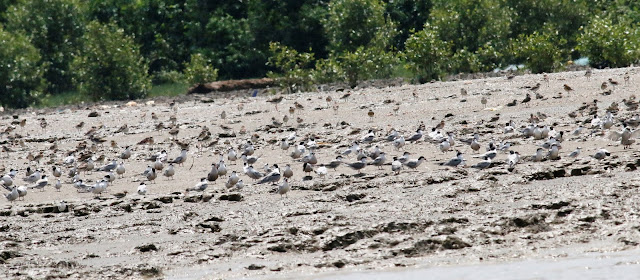In June 2020 I have surveyed the intertidal flats at Kuala Muda, Peninsular Malaysia and I have another opportunity to conduct a survey again in August 2020. Unfortunately the timing of the tides are not so ideal - the receding tides happened in the early hours of the morning. Hence the waders were at the edge of the shoreline when i reached the place.
Then came the bigger waders - here is a flock of Black-tailed Godwits with some Asian Dowitchers on the bottom right of the photo.
Followed by a flock of Asian Dowitcher. I have counted about 50 of them. This number is certainly a far cry from the numbers recorded in Qingkouhe mudflat in China. There the researchers have recorded close to 22K in a day which is equivalent to about 73% of the global population (BirdingAsia # 32). But chances of seeing them are higher in the Northern Peninsular Malaysia as compared to other areas such as the North-Central of Selangor coastline.
It was the same situation on my second visit i.e two days after the earlier one. The waders stayed quite a distance away.
They were mainly scattered everywhere on the mudflat and I have only surveyed about 200 - 300 meters of the total area.
Some did came close like these ones.
This one is almost to its winter plumage. I believe its a juvenile Lesser Sand Plover - highlighted by its peachy wash color on breast and face.
Red-necked Stint
When the Brown-headed Gulls arrive in October, they will usually replace them (the terns) at this location.
A pair of Little Egrets
A Grey Heron casually strolling along the flats.
A wide angle view of the terns and waders.
They were mainly Common Terns with a few Little Terns (at the bottom) accompanying them.
More terns taking flight.
Once awhile some of them will fly close by.
This is a Common Tern (S.h longipennis)
Here is a small group of Asian Dowitchers together with other waders.
You will never get bored of watching waders/shore birds !




























No comments:
Post a Comment